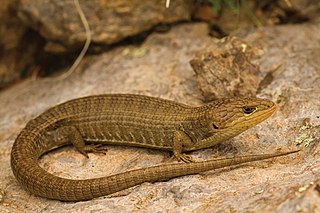
Laemanctus is a genus of lizards in the family Corytophanidae. Species in the genus Laemanctus are commonly referred to as conehead lizards or casquehead iguanas. The genus is endemic to Central America.

Spiny lizards is a common name for the genus Sceloporus in the family Phrynosomatidae. The genus is endemic to North America, with various species ranging from New York, to Washington, and one occurring as far south as northern Panama. The greatest diversity is found in Mexico. This genus includes some of the most commonly seen lizards in the United States. Other common names for lizards in this genus include fence lizards, scaly lizards, bunchgrass lizards, and swifts.

Typhlosaurus is a genus of African lizards, one of a number of genera of limbless lizards in the skink family (Scincidae). This group was recently revised with most species formerly attributed to Typhlosaurus now placed in Acontias. The current definition of Typhlosaurus includes five attenuate body legless lizards from southwestern Africa. This is the sister genus to Acontias, which together form the well supported Afrotropical subfamily Acontinae.

Abronia is a genus of lizards in the family Anguidae that is native to Mexico and Central America. The majority of the species are restricted to southern Mexico and Guatemala, but members of the genus occur as far south as Panama. They inhabit forests and woodlands, mostly in highlands, and some species are often associated with bromeliads. They are typically arboreal, but there are also terrestrial Abronia species. Many species are considered threatened due to habitat loss, killing by locals who mistakenly believe they are venomous, or collection for the captive reptile trade. They feed on small animal prey, such as insects, and the females give birth to live young.

Barisia is a genus of lizards in the family Anguidae. The genus is endemic to Mexico.

The northern alligator lizard is a species of medium-sized lizard in the family Anguidae. The species is endemic to the North American west coast.

Arend Friedrich August Wiegmann was a German zoologist and herpetologist born in Braunschweig.
An alligator lizard is any one of various species of lizards in the family Anguidae that have some shared characteristics. The term may specifically refer to:

The Texas alligator lizard is a species of lizard in the subfamily Gerrhonotinae of the family Anguidae. The species is endemic to the central region of the American state of Texas, and south into adjacent northern Mexico.

Staurotypus is a genus of aquatic turtles, commonly known as giant musk turtles, Mexican musk turtles, or three-keeled musk turtles, in the family Kinosternidae. The genus contains two recognized species, which are endemic to Mexico and Central America. Both species are sold and bred as pets.

Abronia deppii, Deppe's arboreal alligator lizard, is an endangered species of arboreal alligator lizard in the family Anguidae. The species was described in 1828 by Arend Friedrich August Wiegmann, and it is endemic to Mexico.

Abronia matudai, Matuda's arboreal alligator lizard, is a species of endangered arboreal alligator lizard in the family Anguidae. The species, which was originally described in 1946 by Norman Hartweg and Joseph Tihen, is endemic to Central America.
The isthmian alligator lizard is a species of lizard of the Anguidae family. G. rhombifer is found in both Costa Rica and Panama. Unlike many lizards near its habitat, individuals have lateral folds. They give birth to live young. Gerrhonotus rhombifer had not been seen for fifty years, prior to being rediscovered in 2000 near Golfito, and is one of the rarest species of lizard in Costa Rica.

Abronia moreletii, commonly known as Morelet's alligator lizard, is a species of lizard in the family Anguidae. The species is endemic to Central America.

The Madrean alligator lizard is a species of lizard in the family Anguidae. The species is endemic to the southwestern United States and adjacent northwestern Mexico.
George Hines Lowery Jr. was an American ornithologist and professor of zoology at Louisiana State University, who pioneered a technique for studying nocturnal bird migration by large-scale observation through telescopes across the United States of America of flocks of birds as they flew at night in front of the face of the moon.
Gerrhonotus farri, also known commonly as Farr's alligator lizard and the Tamaulipan alligator lizard, is a species of lizard in the family Anguidae. The species is native to northeastern Mexico.

Gerrhonotus liocephalus, the Texas alligator lizard or Wiegmann's alligator lizard, is a species of lizard of the Anguidae family. It is found in Texas, Mexico and Guatemala.

Gerrhonotus lugoi, Lugo's alligator lizard, is a species of lizard of the Anguidae family. It is found in Mexico.

Abronia gadovii, also known commonly as Gadow's alligator lizard and el escorpión de Gadow in Mexican Spanish, is a species of lizard in the family Anguidae. The species is endemic to the highlands of the Sierra Madre del Sur in Guerrero and Oaxaca, Mexico. Two subspecies are recognized:
















